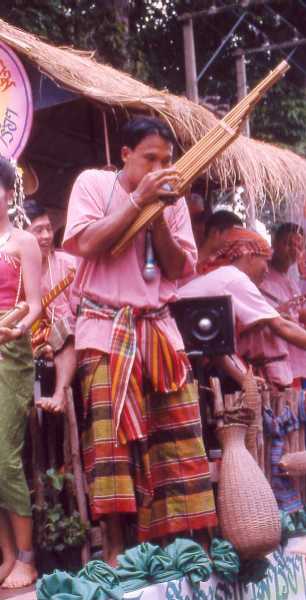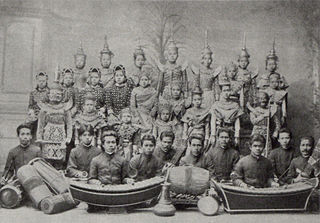Related Research Articles
Progressive metal is a broad fusion music genre melding heavy metal and progressive rock, combining the loud "aggression" and amplified guitar-driven sound of the former with the more experimental, cerebral or quasi-classical compositions of the latter.

Northeast Thailand or Isan consists of 20 provinces in northeastern Thailand. Isan is Thailand's largest region, on the Khorat Plateau, bordered by the Mekong River to the north and east, by Cambodia to the southeast and the Sankamphaeng Range south of Nakhon Ratchasima. To the west it is separated from northern and central Thailand by the Phetchabun Mountains. Isan covers 167,718 km2 (64,756 sq mi), making it about half the size of Germany and roughly the size of England and Wales. The total forest area is 25,203 km2 (9,731 sq mi) or 15 percent of Isan's area.
Lam or LAM may refer to:
Traditional Lao music can be divided into classical and folk forms.

The khaen is a Lao mouth organ whose pipes, which are usually made of bamboo, are connected with a small, hollowed-out hardwood reservoir into which air is blown. The khene is the national instrument of Laos. The khene music is an integral part of Lao life that promotes family and social cohesion and it was inscribed in 2017 on the UNESCO Representative List of the Intangible Cultural Heritage of Humanity. It is used among the ethnic Lao Isan and Some tai ethnic groups such as Tai dam In north Vietnam and Lao population of the province of Stung Treng and is used in lakhon ken, a Cambodian dance drama genre that features the khene as the main instrument In Vietnam, this instrument is used among the Tai peoples and the Muong people.
The music of Laos includes the music of the Lao people, a Tai ethnic group, and other ethnic groups living in Laos. The traditional music of Laos has similarities with the traditional music of Thailand and Cambodia, including the names of the instruments and influences and developments. To categorize Lao music, it seems helpful to distinguish between the nonclassical folk traditions, the classical music traditions and its basic ensembles, and vocal traditions.

The music of Thailand reflects its geographic position at the intersection of China and India, as well as historical trade routes including with Africa, Greece and Rome.

Mor lam is a traditional Lao form of song in Laos and Isan. Mor lam means 'expert song', or 'expert singer', referring to the music or artist respectively. Other romanisations used include mor lum, maw lam, maw lum, moh lam, mhor lum, and molum. In Laos, the music is known simply as lam (ລຳ); mor lam (ໝໍລຳ) refers to the singer.

Kai yang or gai yang, also known as kai ping or gai ping, or pīng kai, is a Lao dish originating in Laos, but it is now commonly eaten throughout the whole of Thailand. The dish is a standard staple of street markets and readily available at all times. Being a typical Laotian dish, it is often paired with green papaya salad and sticky rice (Thai/Isan: ข้าวเหนียว, pronounced[kʰâːwnǐa̯w]; Lao: ເຂົ້າໜຽວ or eaten with sticky rice in bamboo. It is also eaten with raw vegetables, and often dipped in spicy sauces such as Laotian jaew bong.

Romvong, Lamvong or Ramwong, Rambung, Vietnamese: lăm-vông) is a type of Southeast Asian dance where both females and males dance in a circle. It is a popular folk-dance in Xishuangbanna (China), Cambodia, Laos, Malaysia and Thailand. It is a slow round dance continuously moving in a circular manner, and incorporates graceful hand movements and simple footwork. Both men and women participate in the same circle.

Laos developed its culture and customs as the inland crossroads of trade and migration in Southeast Asia over millennia. As of 2012 Laos has a population of roughly 6.4 million spread over 236,800 km2, yielding one of the lowest population densities in Asia. Yet the country of Laos has an official count of over forty-seven ethnicities divided into 149 sub-groups and 80 different languages. The Lao Loum have throughout the country's history comprised the ethnic and linguistic majority. In Southeast Asia, traditional Lao culture is considered one of the Indic cultures.
The dance and theatre of Laos is the primary dramatic art form of Laos' majority ethnic group, the Lao people. It is shared with the ethnic Lao that inhabit the Isan region of Thailand as well. There are mainly two types of dances, the classical dances performed in the royal courts and the folk dances now associated with morlam.

Lam Lueang or Lam Lüang is a musical genre developed in Laos. Inspired by Thai music, it combines singing and story-telling, improvisation, and dance. Lam Luang centers around story-telling through music and specifically focuses on retelling folklore and epics through music, but has also be used to reflect on modern community concerns by contemporary artists.
Kenneth Ploen was an American professional football player who was a quarterback for the Winnipeg Blue Bombers of the Canadian Football League (CFL). He played college football for the Iowa Hawkeyes.

Operation Lam Son 719 or 9th Route – Southern Laos Campaign was a limited-objective offensive campaign conducted in the southeastern portion of the Kingdom of Laos. The campaign was carried out by the armed forces of South Vietnam between 8 February and 25 March 1971, during the Vietnam War. The United States provided logistical, aerial and artillery support for the operation, but its ground forces were prohibited by law from entering Laotian territory. The objective of the campaign was the disruption of a possible future offensive by the People's Army of Vietnam (PAVN), whose logistical system within Laos was known as the Ho Chi Minh Trail.

Tai Nüa is one of the Tai ethnicities in South East Asia. They are mostly found in the Yunnan Province of China, Laos, Thailand, Burma and Vietnam and some have emigrated to the United States of America. There are however two different groups of Tai people called Tai Nua, one in China and Burma, the other in Laos.

Or Lam is a mildly spicy, slightly tongue numbing, Laotian stew originating from Luang Prabang, Laos. The peppery and thick broth is prepared by slowly simmering lemongrass, chilies and Lao chili wood (sakhaan) with crushed or mashed up sticky rice, grilled citronella, garlic, dill and onions added to thicken the broth.

Phi Fa is a deity or spirit in the local folklore of Thailand and Laos. It is also known as Phi Thaen. They play a prominent role in the Phra Lak Phra Lam and the stories of Khun Borom.
Lao pop or L-pop is a music genre of pop music of Lao people.
References
- Terry E. Miller, "Laos, 6:Relationship With Musics of North-East Thailand". The New Grove Dictionary of Music and Musicians . Macmillan, 2001.